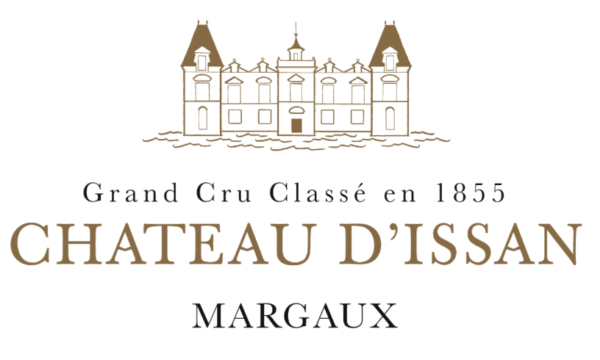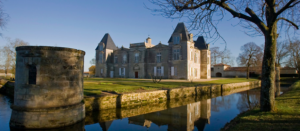
Overview
Château d’Issan is a castle and winery in the Margaux appellation of the Bordeaux region of France. The wine produced here was classified as one of fourteen Troisièmes Crus (Third Growths) in the historic Bordeaux Wine Official Classification of 1855. The winery is under the proprietorship of Emmanuel Cruse, of the Cruse family. In February 2013, 50% of the estate was purchased by Jacky Lorenzetti, who also owns Château Pédesclaux in Pauillac & Chateau Lilian Ladouys in Saint-Estèphe.
History
At the very beginning, there was a fortress in the seigneury of La Mothe-Cantenac. The 12th century building was demolished five hundred years later by Baron d’Essenault when he inherited the estate. In its place he had the present property built, which today still has some beautiful medieval features, such as its imposing gateway, its towers and its moat, relics of its former defences. A wall built in 1644 still surrounds the vineyard. The chateau is lived in today, having undergone several phases of renovation. In 1970, after the Cruse family undertook refurbishment work, the chateau was included on the French complementary list of historical buildings.
The Terroir
Acreage : 59 Ha
44 Ha Margaux
5 Ha Haut-Médoc
10 Ha Bordeaux Supérieur
Planting density: 8.500/Ha
Château d’Issan is in the middle of the Margaux appellation, a truly privileged location, which explains the outstanding quality of its wines. The mild weather, regulated by being close to the sea and the Gironde Estuary, provides ideal conditions for vine growth. The soil is made up of mounds of gravel and 15-metre (50-foot) high alluvial hills, rounded by erosion. Nothing much remains of the pre-Revolution estate: bad weather, wars and phylloxera outbreaks took a heavy toll over the centuries. Today’s vines are 35 years old on average and result mainly from the Cruse family’s restoration efforts after 1945.
Vinification
 The vines at Château d’Issan benefit from close, on-going care designed to produce perfectly ripe grapes. Everything is organised so that each individual plot can be tended independently in order to get the very best out of its fruit. In winter, the specific Medoc pruning method is applied in conjunction with intimate knowledge of the vines to regulate the coming year’s production. In spring, traditional tilling is carried out, improving air and water circulation thereby ensuring that activity in the soil starts up again naturally and for maximum benefit. This is followed by desuckering and the elimination of secondary shoots to stimulate ripening of the bunches. The removal of green fruit and leaves ensues and continues on to summer with the aim of ensuring good grape concentration. As soon as the harvest arrives in the vathouse, we initially sort the bunches, then the grapes are screened a second time on a vibrating table and gravity-fed into separate tanks to preserve the distinctive characteristics of the different plots in the vineyard. We have invested in 37 temperature-controlled stainless steel tanks with capacities from 70 to 200 hectolitres.
The vines at Château d’Issan benefit from close, on-going care designed to produce perfectly ripe grapes. Everything is organised so that each individual plot can be tended independently in order to get the very best out of its fruit. In winter, the specific Medoc pruning method is applied in conjunction with intimate knowledge of the vines to regulate the coming year’s production. In spring, traditional tilling is carried out, improving air and water circulation thereby ensuring that activity in the soil starts up again naturally and for maximum benefit. This is followed by desuckering and the elimination of secondary shoots to stimulate ripening of the bunches. The removal of green fruit and leaves ensues and continues on to summer with the aim of ensuring good grape concentration. As soon as the harvest arrives in the vathouse, we initially sort the bunches, then the grapes are screened a second time on a vibrating table and gravity-fed into separate tanks to preserve the distinctive characteristics of the different plots in the vineyard. We have invested in 37 temperature-controlled stainless steel tanks with capacities from 70 to 200 hectolitres.

Château D'Issan Margaux 3ème Grand Cru Classé
Overview: Château d’Issan is a Third Growth of the 1855 Imperial Classification. The wine is made from the old vines in the Château d’Issan enclosure in the middle of the Margaux appellation.
Soil: The soil here is mainly made up of surface gravel on top of a clay subsoil, which contributes to optimal ripeness and freshness in the two grape varieties.
Grape Blend: Cabernet Sauvignon and Merlot
Tasting Notes: Château d’Issan expresses the exquisite bouquet so characteristic of Margaux, and stands out with its suppleness, subtlety, elegance, and long keeping potential that come from its unique terroir.
Aging: Château d’Issan is aged in barrels for 16 to 18 months, half of which are new.
Annual Production: Around 100,000 bottles

Blason d’Issan
Overview: Blason d’Issan, our second wine, was introduced from 1995 onwards to enable selection amongst our vines growing in the Margaux appellation area. Fruit from our youngest vines is used to produce this wine, which respects the identity of its terroir, while offering a tasty round fruitiness, which can be enjoyed earlier.
Grape Blend: Cabernet Sauvignon, Merlot
Average age of the vine: 18 years old
Production: 5.000 cases per year
Aging: Blason d’Issan is also aged in barrels for 14 to 16 months, one third of which are new.
Production: Annual production is around 120,000 bottles.

Moulin d'Issan Bordeaux Supérieur
Overview: The Bordeaux wine growing area is known for its variety of soil types and sub-soils. To the right of the historic path that leads to Château d’Issan are the Bordeaux Supérieur AOC plots. They are the closest to the Gironde Estuary. The soil there is mainly clayey limestone and therefore particularly suited to the Merlot grape variety, which dominates in this part of the vineyard. Generally, it contributes 90% of the blend, which is unique in the Medoc. The ruins of the old 17th century windmill, which gave this wine its name, are still in the middle of the vineyard. This wine expresses the richness, the suppleness and the fruit of its origins; it has been on the market since 1988.
Grape Blend: Merlot, Cabernet Sauvignon
Harvest: Hand picked at end of September through October
Aging: 14 months in 25% new barrels
Annual Production: About 40,000 bottles
Tasting Notes: Shows an expressive and crunchy red fruit character with a deep color. The finish is very well balanced with fine tannins.



